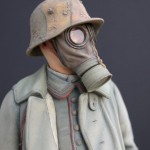
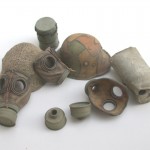
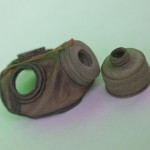
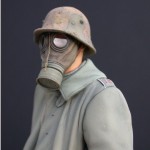
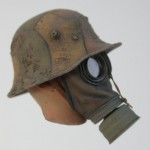
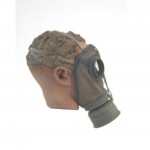
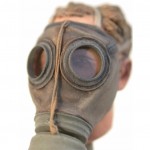
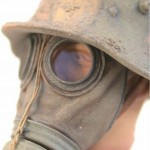
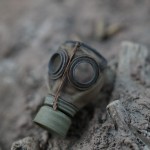
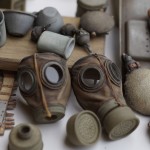
German Gas Mask M1917 Set
- Scale / Maßstab: 1:16
- Material: Resin / Acryl Glass (Plexi)
- Parts / Teile: 19
- Infosheet / Infoblatt: English
- Code: 01SP
Contents / Inhalte:
- 3 x Gas Mask M. 17 / 3 Stck. Ledermaske (Gasmaske M.17)
- 3 x Gas Mask Filter / 3 Stck. Filter
- 6 x Eyepieces (Acryl Glass) / 6 Stck. Augengläser
- 3 x Heads (Half, Full and with Field Cap M1910) / 3 Köpfe (halb, voll und mit Feldmütze)
- Canvas Gas Mask Holder / Segeltuchtasche für Gasmaske
- Gas Mask Container / Gasmasken-Behälter M1917 (Bereitschaftsbüchse 17)
- Steel Helmet / Stahlhelm M.16
- Steel Helmet with Sandbag Covering / Stahlhelm M.16 mit Überzug
Extracts from the Infosheet with this kit:
Gas Mask M. 17 / Ledermaske (Gasmaske M.17): The replacement mask for the Gasmaske M. 15 (Linienmaske), made out of sheep leather and impregnated with special gas proofing oils. The mask incorporated only 3 seams in the material, an overall improvement from the M.15 mask reducing the risk of leakage. The fixed celluloid glass eye pieces were coated with gelatine on the inside to avoid misting up, which in turn was protected by a metal Spinne, or spider metal frame to also avoid scratching / smearing – these could be removed for cleaning etc. Apart from the new cone appearance, the important difference over the previous mask was the position of the eyepieces. These were set at an angle with a larger gap in between, avoiding earlier blind spots each side of the head. The protruding metal rings on the outside of the eyepieces protected the glass from scratches. The first part of the straps were part rubberised (reinforced with wire) and part cloth. The cord on the front of the mask could be shortened, lifting the filter, thus enabling a better vision for wearer – this was optional and left for the individual to decide. The filter can after the excess resin / casting-canal are removed be screwed onto the mask just like on the original. The position of the straps around the side and rear of head have been copied from a collector wearing an original mask, as few original photos exist where no headdress is worn. Colour: original masks differ in colour from light to dark leather. The outer seal (nearest to face) appears always darker. Metal eye rings – matt silver. Filter and filter/fitting – grey-green.
Also supplied are the 3 sets of computer cut eyepieces in 0.25 mm plexi glass. These are to be inserted to the inside of the masks before fixing to the face.
3 heads have been supplied with the mask: Head No. 1 – full, with no headdress. Head No. 2, wearing the field cap. Head No. 3, half head, enabling the wearing of a steel helmet – of cause most masks would have been worn in conjunction with the steel helmet.
A light material strap was used to enable the mask to hang around the neck when not in use, whenever danger of gas was imminent – this can be made out of thin card supplied, paper or something similar and glued into the small indents each side (inside) of the mask. The mask has been so constructed so as to fit over the face of the heads supplied in the set, although slight alterations maybe needed at the end of the nose.
Canvas Gas Mask Holder / Segeltuchtasche für Gasmaske: In 1915 a canvas gas mask holder was issued with 2 dividing partitions within, which stowed the mask, filter and reserve-filter in a metal tin. The holder was generally worn either attached to the belt below the rucksack at the rear, or on the right side / front by means of 2 belt loops made from the same material and fastened with zinc buttons. Later versions of the holder had ring attachments on each of the belt loops enabling the fixing to the bread bag. Although generally used in the early part of the war, late war photos still show troops issued with this holder. The No. 2 at one end of the holder is the gas mask size and this has been modelled slightly raised to enable easier painting. On the model, part of the flap has lifted to reveal one side of the metal tin containing the spare filter. Colour: canvas holder – light grey- brown, number – dark coloured stamp colour – could have been black (on the original items these numbers are quite faded), filter tin – grey-green.
Gas Mask Container / Gasmaske M1917: The gas mask was kept in a metal container, which had a brown cloth strap. Troops serving in the frontline area often wore it in the alert position in front of the chest. There was no room for the reserve filter in the container. Through constant use the containers became dented. Colour: grey.
Steel Helmet M16 / Stahlhelm M.16: This helmet, which first entered service in 1916 during the initial stages of the battle of Verdun was designed by Professor Friedrich Schwerd and made from high quality chrome-nickel steel. Weighing between 950 and 1200g, depending on size – more heavier than the Allied helmets, but giving a better protection to the face, ears and neck. The horn venting bolts on each side enabled the fitting of an extra armoured shield over the helmet (also available in 1:16th scale from Jon Smith Modellbau) for sentries, MG troops, snipers or other particularly exposed / dangerous employment. This weighing around 2000g was seldom used; although a total of 50000 were supposedly produced.
Colour: issued in field- grey, which would reflect in sun light and proved unsatisfactory. Various trials were carried out, but it was not until July 1918 that an official camouflage scheme in brown and green sharp-edged irregular patens, all outlined in black was introduced. These were carried out by unit maintenance workshops (other weapons and equipment, particularly artillery pieces and MGs were also rendered in the same way). It seems that helmets were re-painted by individuals or units in a variety of colour schemes before the official order and items with red- brown, ochre (brownish- yellow), green and blue- grey, all outlined in black were common. Helmets were also covered using the light brown sandbag material, or the issued helmet-covers, seen particularly in the later war period.
The M.17 & 18 helmets followed with only slight differences to the inside padding and chin strap fasteners. The last model to see service during the war, if only in small numbers was the M.18 Ohrenausschnitt, or Helmet M.18 with ear cut-outs (also available in 1:16th scale from JSM), more commonly (and stubbornly) known as the Cavalry or Telegraph Helmet. The cut-outs were in fact a further design feature of the M.18 to improve the hearing ability of the wearer and avoid the hissing noise experienced by troops.
 An deutschsprachige Interessenten:
Sie können mich per eMail oder Telefon auch gerne auf deutsch kontaktieren. Ortsbesuch ist nach Absprache möglich.
An deutschsprachige Interessenten:
Sie können mich per eMail oder Telefon auch gerne auf deutsch kontaktieren. Ortsbesuch ist nach Absprache möglich.
